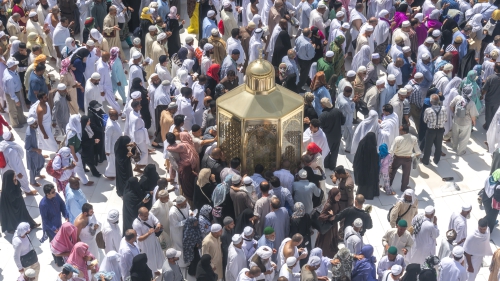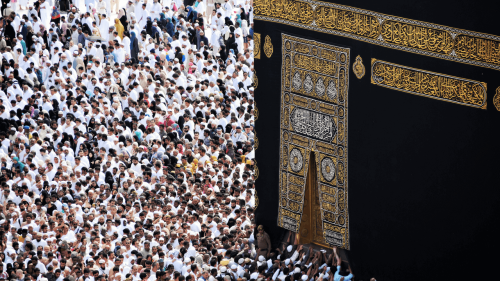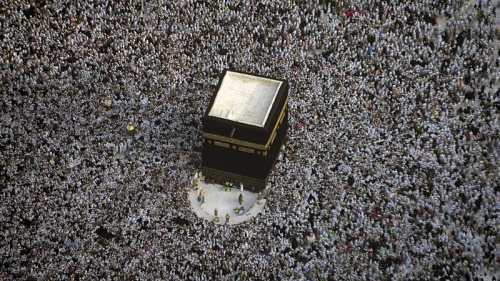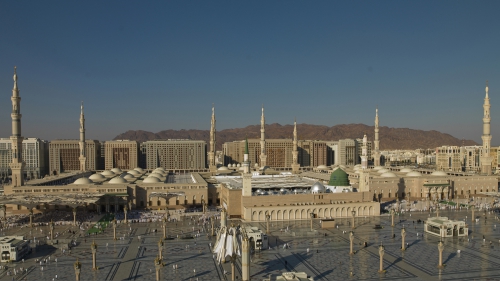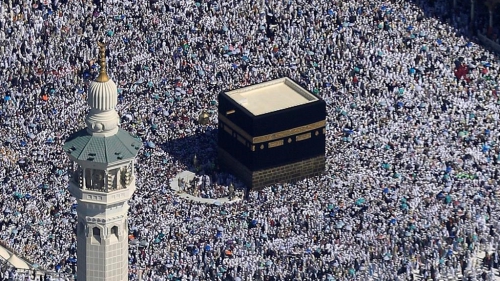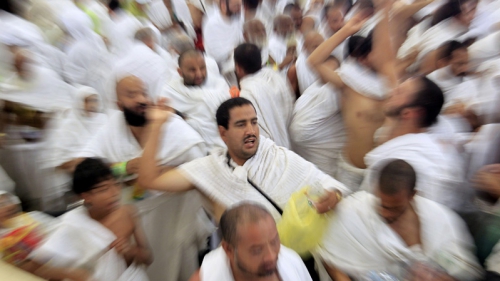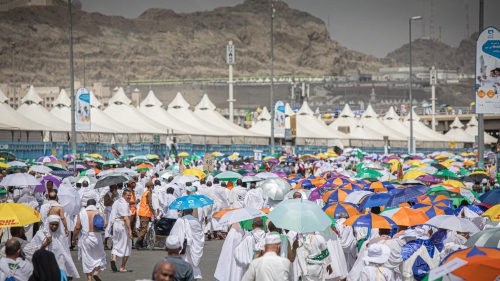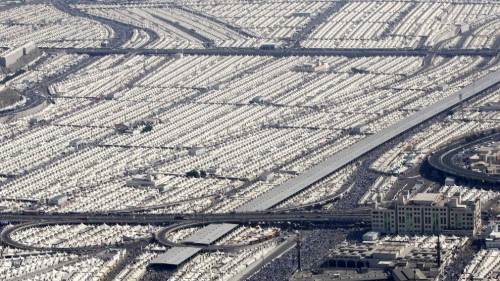The Hajj Journey

Allah prescribed Hajj once in a lifetime upon the Muslims who have the means and are physically able to perform it. There are three types of Hajj: Hajj at-Tamattu', Hajj al-Qiran and Hajj alIf rad. In this article, we will explain the procedure for Hajj Al-Tamatt'u as it is the most recommended one.
In this type, one is to perform 'Umrah during the Hajj months (i.e. Shawwal, Thul-Qe'dah and the first ten nights of Thul-Hijjah) and to perform the Hajj in the same year with a sacrifice slaughtered in Mina on the day of Eid AlAdh'ha (The 10th day of Thul-Hijjah) or during the days of Tashreeq (i.e. the 11th, 12th and 13th day of Thul-Hijjah). The pilgrim may remove his Ihram garments and resume his normal activities between 'Umrah and Hajj. It is necessary to make the Tawaf and the Sa'i twice, the first time for 'Umrah and the second time for Hajj. We describe in the following the sequence of the Hajj journey.

Graphical Representation of the Hajj Journey
Ihram
Ihram is the intention of the person willing to perform all rites of 'Umrah, Hajj or both when he arrives at the Miqat. Each direction coming into Makkah has its own Miqat. It is recommended that the one who intends to perform Hajj makes Ghusl (a shower with the intention to purify one's self), perfumes his body, but not his garments, and puts on a two piece garment with no headgear. The garments should be of seamless cloth. One piece to cover the upper part of the body, and the second to cover the lower part. For a woman the Ihram is the same except that she should not use perfumes at all and her dress should cover the whole body decently, leaving the hands and the face uncovered. The pilgrim should say the intention according to the type of Hajj. For Hajj Al-Tamatt'u one should say: "Labbayka Allahumma 'Umrah" which means "O Allah I answered Your call to perform 'Umrah". It is recommended to repeat the well known supplication of Hajj, called Talbeyah, as frequently as possible from the time of Ihram till the time of the first stoning of Jamrat Al-Aqabah in Mina. Men are recommended to utter the Talbeyah aloud while women are to say it quietly. This Talbeyah is of the form:
"Labbayka Allahumma Labbayk. Labbayka La Shareeka Laka Labbayk. Inna-alhamda Wan-ntimata Laka Walmulk. La Shareek Lak." (Here I am at your service. O my Lord, here I am. Here I am. No partner do You have. Here I am. Truly, the praise and the provisions are Yours, and so is the dominion. No partner do You have.)
Performing 'Umrah
Tawaf: When a Muslim arrives to Makkah, he should make Tawaf around the Ka'bah, as a gesture of greeting A1Masjid Al-Haraam. This is done by circling the Ka'bah seven times in the counterclockwise direction, starting from the black stone with Takbeer and ending each circle at the Black Stone with Takbeer, keeping the Ka'bah to one's left. Then the pilgrim goes to Maqam Ibrahim (Ibrahim's Station), and performs two rak'ah behind it, close to it if possible, but away from the path of the people making Tawaf. In all cases one should be facing the Ka'bah when praying behind Maqam Ibrahim.
Sa'i: The next rite is to make Sa'i between Safa and Marwah. The pilgrim starts Sa'i by ascending the Safa. While facing the Ka'bah he praises Allah, raises his hands and says Takbeer "Allah-u Akbar" three times, then makes supplication to Allah. Then the pilgrim descends from the Safa and heads towards the Marwah. One should increase the pace between the clearly marked green posts, but should walk at a normal pace before and after them. When the pilgrim reaches the Marwah, he should ascend it, praise Allah and do as he did at the Safa. This is considered one round and so is the other way from the Marwah to the Safa. A total of seven rounds are required to perform the Sa'i. After Sa'i, the Muslim ends his 'Umrah rites by shaving his head or trimming his hair (women should cut a finger tip's length from their hair). At this stage, the prohibitions pertaining to the state of Ihram are lifted and one can resume his normal life.
There are no required formulas or supplications for Tawaf or for Sa'i. It is up to the worshipper to praise Allah or to supplicate Him with any acceptable supplication or to recite portions of the Qur'an. Although it is recommended to recite the supplications that the Prophet, salla Allah-u alaihe wa salam, used to say during the performance of these rites.
It must be noted that 'Umrah can be performed by itself as described above at any time of the year.
Going out to Mina on the day of Tarwiah
A pilgrim performing Hajj AlTamatt'u should intend Ihram, from the place where he is staying, on the 8th day of Thul-Hijjah, which is the Tarwiah Day, and leave to Mina in the morning. In Mina, the pilgrims pray Dhuhr, Asr, Maghrib and Isha of the 8th day of ThulHijjah and Fajr of the 9th day of ThulHijjah. Dhuhr, Asr and Isha are each shortened to two Rak'ah only, but are not combined. The pilgrim remains in Mina until sunrise of the 9th day of ThulHijjah and then leaves to Arafat.
Departure to Arafat
On the 9th day of Thul-Hijjah, the Day of Arafat, the pilgrims stay in Arafat until sunset. The pilgrims pray Dhuhr and Asr at Arafat, shortened and combined dur ing the time of Dhuhr to save the rest of the day for glorifying Allah and for supplication asking forgiveness. A pilgrim should make sure that he is within the boundaries of Arafat, not necessarily standing on the mountain of Arafat. The Prophet salla Allah-u alaihe wa salam, said: "I stood here on this rocky hill and all Arafat is a standing place" Muslim. One should keep reciting Talbeyah, glorifying Allah the Greatest and repeating supplication. It is also reported that the Prophet, salla Allah-u alaihe wa salam, used to say the following supplication: "There is no deity worthy of worship except Allah, the One without a partner. The dominion and the praise are His and He is powerful over everything." Anas Ibn Malik was asked once how he and his friends used to spend their time while walking from Mina to Arafat in the company of the Prophet, salla Allah-u alaihe wa salam. Anas said: "Some of us used to cry out Talbeyah, others used to glorify Allah the Greatest and the rest used to repeat prayers. Each one of us was free to worship Allah in the way he likes without prejudice or renunciation of his right." Bukhari.
In the vast square plain of Arafat, tears are shed, sins are washed and faults are redressed for those who ask Allah for forgiveness and offer sincere repentance for their wrong doings in the past. Happy is the person who receives the Mercy and Pleasure of Allah on this particular day.
The departure from Arafat
Soon after sunset on the Day of Arafat, the pilgrims leave for Muzdalifah quietly and reverently in compliance with the advice of the Prophet, salla Allah-u alaihe wa salam, who said when he noticed people walking without calmness: "O people! Be quiet, hastening is not a sign of righteousness." Bukhari. In order to follow the example of the Prophet, salla Allah-u alaihe wa salam, it is preferable to keep reciting the Talbeyah, glorifying Allah the Greatest and mentioning the name of Allah until the time of stoning Jamrat Al-Aqabah (a stone pillar in Mina). In Muzdalifah, the pilgrim performs Maghrib and Isha prayers combined, shortening the Isha prayer to two Rak'ah.Pilgrims stay overnight in Muzdalifah to perform the Fajr prayer and wait until the brightness of the morning is widespread before they leave to Mina passing through the sacred Mash'ar valley.
Women and weak individuals are allowed to proceed to Mina at any time after midnight to avoid the crowd.
Stoning Jamrat Al-Aqabah
When the pilgrims arrive at Mina, they go to Jamrat Al-Aqabah where they stone it with seven pebbles glorifying Allah "Allah-u Akbar" at each throw and calling on Him to accept their Hajj. The time of stoning Jamrat Al-Aqabah is after sunrise. The Prophet, salla Allah-u alaihe wa salam, threw the pebbles late in the morning and permitted weak people to stone after leaving Muzdalifah after midnight. The size of the pebbles should not be more than that of a bean as described by the Prophet, salla Allahu alaihe wa salam, who warned against exaggeration. The pebbles can be picked up either in Muzdalifah or in Mina.
Slaughter of Sacrifice
After stoning Jamrat Al-Aqabah, the pilgrim goes to slaughter his sacrifice either personally or through the appointment of somebody else to do it on his behalf. A pilgrim should slaughter either a sheep, or share a cow or a camel with six others.
Shaving the head or trimming the hair
The final rite on the tenth day after offering his sacrifice is to shave one' s head or to cut some of the hair. Shaving the head is, however, preferable for it was reported that the Prophet prayed three times for those who shaved their heads, when he said: "May Allah's Mercy be upon those who shaved their heads." Bukhari and Muslim. For women, the length of hair to be cut is that of a finger tip. The stoning of Jamrat Al-Aqabah and the shaving of head or trimming of hair symbolizes the end of the first phase of the state of Ihram and the lifting of its restrictions except for sexual intercourse with one's spouse. Stoning Jamrat Al-Aqabah, slaughtering the sacrifice and shaving the head or cutting part of the hair are preferred to be in this order, as it is the order that the Prophet, salla Allah-u alaihe wa salam, did them. However, if they are done in any other order, there is no harm in that.
Tawaf Al-Ifadhah
Tawaf Al-Ifadhah is a fundamental rite of Hajj. The pilgrim makes Tawaf-AIIfadhah by visiting Al-Masjid AlHaraam and circling the Ka'bah seven times and praying two Rak'ah behind Maqam Ibrahim. Then the pilgrim should make Sa'i between the Safa and the Marwah. After Tawaf Al-Ifadhah the state of Ihram is completely ended and all restrictions are lifted including sexual intercourse with one's spouse.
Tawaf Al-Ifadhah can be delayed until the days spent at Mina are over.
Return to Mina
The pilgrim should return to Mina and spend there the days of Tashreeq (i.e. the I I th, 1 2th and 1 3th day of Thul-Hijjah). l During each day, and after Dhuhr prayer, | the pilgrim stones the three stone pillars called "Jamarat": The small, the medium and Jamrat Al-Aqabah, glorifying Allah "Allah-u Akbar" with each throw of the seven pebbles stoned at each pillar. These pebbles are picked up in Mina. A l Pilgrim may leave Mina to Makkah on the 13th of Thul-Hijjah or on the 12th if he wishes, there is no blame on him if he chooses the later, but he has to leave before sunset.
Farewell Tawaf
Farewell Tawaf is the final rite of Hajj. It is to make another Tawaf around the Ka'bah. Ibn Abbas said: "The people were ordered to perform the Tawaf around the Ka'bah as the last thing before leaving Makkah, except the menstruating women who were excused." Bukhari.
Related Suggestions
I have taken over 30 hours of classes for my up coming hajj. I think the more I learn the better it would be for me, while performing hajj.
My tears are falling just reading this article. Allah is very meriful and forgiving to invite me to be his guest.
I am overwhelm just thinking that I would be walking where prophets walk, especially our Rasul, peace be upon him.








